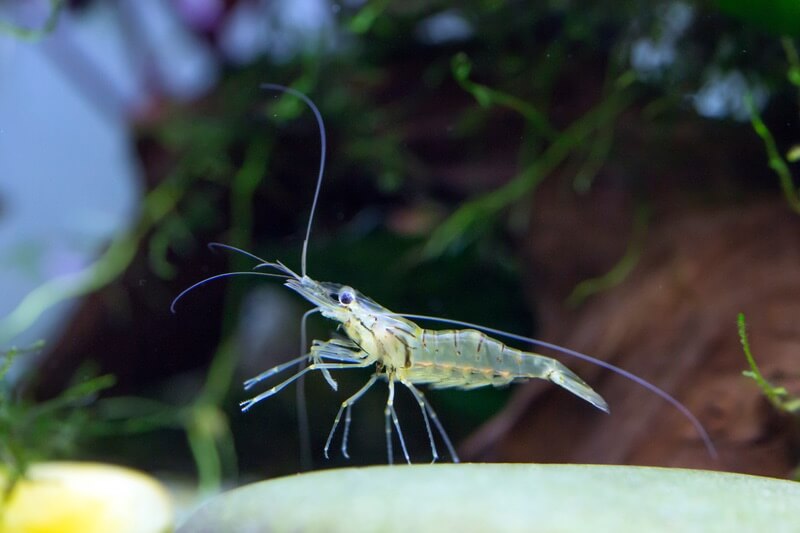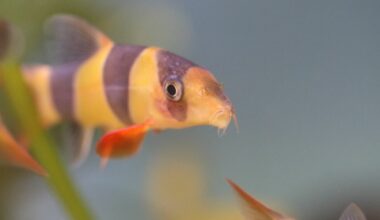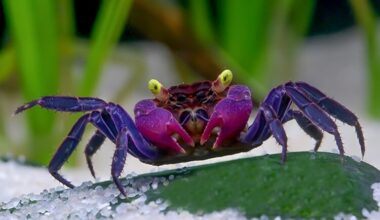We’ve been a big fan of ghost shrimp for a while now, and it goes a little further than the reasons you’ll hear from other freshwater tank owners.
Sure, these little critters are incredibly useful for aquarists who want great tank cleaners or need live feed for other fish. There’s no denying that.
However, we also think they can make very fun pets for the right kind of hobbyist. Their busy nature, unique appearance, and peaceful temperament are all great reasons why you should give ghost shrimp a shot.
This means no matter who you are, as long as you have a freshwater tank you should probably consider getting some.
That’s why we thought it was so important to put together this resource for you. In this guide, we’ll cover everything you need to know when it comes to ghost shrimp, no matter how you’ll be using them!
Table of Contents
What Are Ghost Shrimp?
Ghost shrimp are a unique type of critter to keep in your freshwater aquarium. For many seasoned aquarists, these small shrimp are used as live feed for much larger creatures. However, others choose to keep them as pets due to their distinct looks and surprisingly playful temperament.

These little animals hail from the fresh waters and lakes in North America. Additional information about their origin is not as well-defined as some other freshwater aquarium shrimp. These critters were formally classified all the way back in the early 1800s!
As the aquarium community started to form and grow, they quickly became useful and common creatures to include in freshwater tanks.
Ghost shrimp are incredibly active, good for the health of your tank (because of the algae they eat), and are easy to breed. Thus, the role that the shrimp play in the world of aquaculture is a big one!
Appearance & Size
Ghost shrimp (palaemonetes paludosus) are sometimes also called Glass Shrimp. Whatever you decide to call them, it’s not hard to see why they received those names. The entire shrimp is transparent.
The reason for this is simple:
Their transparent nature is used as a defense mechanism in the wild. It’s very difficult for most of their natural predators to spot them as they scavenge the bottom of the riverbed.
Even in a fish tank, they can sometimes be hard to spot among decor and plants.
With that being said, there are some slight variations in appearance that you can see. Some subspecies have subtle markings on their backs. These will typically come in the form of colorful dots.
Anatomy Breakdown
Beyond that, you can always look for their internal organs. Despite the clear exteriors, ghost shrimp have fully visible eyes and digestive tracts.
If you can get close enough to examine your shrimp, you’ll notice a segmented body. The largest portion, called the carapace, is tough. it’s meant to protect all of the important organs underneath, such as the heart, brain, gills.
The tip of the carapace is called the rostrum. It’s a rigid beak-like section that’s often used for rummaging through the sediment. While they’re usually peaceful, this jagged body part can also be used for defense if it’s needed.
Beady little eyes can be found poking out from either side of the rostrum base. Look a little further, and you’ll see two pairs of antennae. One pair is long while the other is short.
The antennae are usually clear like the rest of the body, though you might see some light coloration on a few ghost shrimp.
These thin antennae are very important for your shrimp’s well-being. They act as sensory organs that help them navigate the environment and gather some crucial information about the chemical composition of the water.
Below the shrimp’s head, you’ll find six flexible segments. They’re much softer and more flexible than the tougher carapace. Look closely, and this section may look very familiar to you.
It looks like any other shrimp that you might have eaten, albeit much smaller. The first five sections are attached to the pleopods, which are limbs used for swimming. The final sixth section holds the tail.
Ghost Shrimp Size
In terms of size, ghost shrimp don’t get much larger than one and a half inches. Females might get a bit bigger than that, but most adult shrimp hover around the same average size.
They’re not that wide either.
Adult shrimp are usually no wider than an eraser on the end of a pencil. They’re much thinner than other freshwater shrimp species, which is one of the many reasons why they’re often the go-to when it comes to live feed.
Ghost Shrimp Care
The great thing about ghost shrimp is that they’re very hardy and easy to care for. In most instances, aquarists won’t have any issues keeping the shrimp healthy.
As with all aquatic life, the key is to keep tank conditions healthy.
Ghost Shrimp Lifespan
Ghost shrimp have a very short lifespan of only one year. During that year, they’ll grow rapidly. Once they outgrow their current exoskeleton, they’ll shed/molt it to grow another one.
This can happen a lot throughout the year, so don’t be surprised if you find several transparent shells around the tank. Fortunately, you don’t have to worry about picking them out.
The shells will quickly become a food source for other shrimp. After shedding, your shrimp will probably hide for a bit. This is because the new shell they get is very thin, making them vulnerable.
Potential Illness And Disease
There are a few diseases that can affect ghost shrimp. They’re rare, but it’s smart to know what they are in case you have to deal with them.
The most common is called Vorticella. It’s a protozoan that can cause your shrimp’s otherwise clear shell to look white and moldy. Vorticella comes from algae and other animals.
Because of the shrimp’s scavenging behavior, they often get it from munching on infected organic matter. Luckily, you can treat it with water changes and salt.
Another issue you might encounter is a bacterial infection. Infections are pretty easy to spot on ghost shrimp because of their clear bodies. It will look like a pinkish swollen spot.
Unfortunately, bacterial infections are almost always fatal. Your best bet would be to remove the affected shrimp and keep an eye on others. The infection can easily be spread to other shrimp.
Ideal Shrimp Tank Conditions
When you walk into a pet shop, you’ll probably find the ghost shrimp in a simple bare tank with no decorations in it at all. These are shrimp that have been delegated as feeders.
However, if you plan on keeping your shrimp as pets you’re going to want to provide them with a nicer environment to live in.
Tank Setup
Fine substrate is best for the bottom of the tank. These creatures are bottom feeders, so they will spend most of their time digging through the sandy bottoms of their environment. There really isn’t a good reason why you should consider alternatives to fine sand.
Tanks with large chunks of gravel are not going to be good for your shrimp. Not only are they impossible for your ghost shrimp to move, but they can actually cut through their exoskeletons and cause harm.
To accompany the sand, fill your tank with plenty of live plants. In the wild, ghost shrimp usually feed on algae and tiny bits of organic matter from the local plant life. Introducing live plants into your tanks will give your shrimp something to clean.
This will also provide them with new places to explore and hide (more on that below). Plants like Java moss and hornwort are best.
Lighting Needs
Ghost shrimp don’t have any specific lighting requirements like other fish. They stay close to the bottom of the tank and don’t have a clear day/night cycle that you have to worry about.
As a result, standard aquarium lighting is all you need. Just make sure that the lighting doesn’t affect temperatures too much if you plan on leaving it on throughout the day.
Minimum Tank Size
At the very least, you should have a 5 gallon tank (larger is better of course). Because the shrimp are so small, they don’t need a ton of room to roam.
For shrimp you want to keep as pets you should aim for a ratio of three to four ghost shrimp per gallon.
What To Include In Their Habitat
While the clear nature of their bodies is great for keeping them hidden, ghost shrimp still need hiding places they can access whenever they’re feeling anxious. If you have other fish in the tank with them, they will need some spots to hide if the fish start to get aggressive.
Plants are the best option. ghost shrimp blend in effortlessly among thick leaves and underwater brush. However, you can also introduce other decorative items.
Rocks, driftwood, and even plastic decorations will do good. Just spread them throughout the bottom of the tank to give your shrimp plenty of places to feel comfortable.
Water Parameters & Quality Needs
When it comes to water quality, ghost shrimp are pretty easy to please. They’re quite hardy and can thrive in most water conditions. Although, we highly recommend sticking with the recommended levels below to ensure that they’re as healthy as possible.
Water Temperature
Ghost shrimp prefer warmer waters. Temperatures between 65 degrees and 82 degrees Fahrenheit should do just fine. Some breeders go beyond that wide temperature range and get away with it, but if you’re keeping them as a pet you should live withing these guardrails.
The reason for this is that most breeders are using their shrimp as live fish food. They don’t care much about the well-being of the shrimp and are causing them stress and health issues by choosing to ignore these water temperature limits.
pH & Hardness Levels
Ghost shrimp prefer a pH balance between 7.0 and 8.0. The water can also be slightly hard. A hardness rating between 3.72 and 6.75 should do just fine.
Pollutants To Keep An Eye On
In addition to staying on top of pH and hardness levels, you should also monitor pollutants. Ghost shrimp don’t have as much biological output as other aquarium creatures. However, a large population of shrimp in a small tank can throw things off balance pretty quickly.
You need to monitor the amount of ammonia, nitrate, and nitrite that’s in your water. Both pollutants have the potential to kill your shrimp. But, they’re also necessary for the growth of aquatic plants, which are needed to keep these shrimp healthy.
It’s a fine balance that you need to monitor regularly. Ammonia and nitrate levels should be kept between 5-10 PPM. You can easily control the levels by performing water changes regularly.
Also, you need to be wary of copper. Copper is found in some fish medications. Unfortunately, it’s fatal to ghost shrimp.
If you need to medicate other fish in the tank, make sure to read the ingredient’s label and steer clear of any copper-based products.
Filtration Requirements
As for filtration, ghost shrimp don’t need much help in this department. They will do a great job contributing to the cleaning process on their own! This means a standard sponge filter will do.
What Do Ghost Shrimp Eat?
As we mentioned earlier, these shrimp are natural scavengers. In the wild, they feed on fish and plant waste. They’re so tiny that they usually aren’t able to eat other creatures!
In a tank environment, these shrimp will do pretty much the same thing. They’ll stick to the bottom of the tank and nibble on anything they can get. You’ll often find them feeding off of the plants you have in the tank or catching fallen pellets that your other fish didn’t eat.
If you have a tank that only has ghost shrimp, the feeding process will be a breeze. They’ll eat any standard flake or pellet food. Pellets are best, as they can sink down to the bottom where they hang out.
Remember, they are tiny. They don’t need a ton of food to keep them healthy. Consider a tiny pinch of flakes for a group of shrimp.
Note: Here’s a common new owner mistake to avoid. You can sometimes see the little shrimp swimming up to the top to nab some flakes, which can make it tempting to encourage them to do it again. Be careful though, it’s possible to overfeed ghost shrimp and this is one of the fastest ways to do it.
General Behavior & Temperament
Ghost shrimp are very peaceful creatures. They don’t bother other fish and will spend most of their time doing their own thing at the bottom of the tank and looking for things to snack on.
To stay safe, they may spend a few days hiding out in the plants, under rocks, or in any other crevice they can find. Because of their clear bodies and shy nature, it can sometimes be hard to locate them in your tank!
Good (And Bad) Tank Mates
The best tank mates for ghost shrimp are any other peaceful small fish. Two of the common choices are:
- Tetras
- Barbs that aren’t too large
You can also pair them with other peaceful bottom dwellers like Kuhli loaches, freshwater snails, Cory catfish, Cherry Shrimp, and Amano shrimp. These tank mates will mind their own business and let your ghost shrimp do their thing undisturbed.
As for tank mates to avoid, you should avoid pairing them with any aggressive fish no matter what.
As a good rule of thumb, don’t put ghost shrimp in the same tank as larger fish that feed off live food and are big enough to consume the shrimp. They’ll immediately go after your precious shrimp, so keep the tank as peaceful as possible.
Ghost Shrimp And Bettas
One of the most common tank mate questions we hear is in regards to betta fish. This is quite common for almost all the care guides we put together due to the popularity of the fish.
In this case, ghost shrimp and betta fish tend to not good tank mates. This isn’t always the case and the translucent nature of your shrimp might keep them out of trouble if your betta is relatively calm.
However, keeping them apart is the safest move to make.
Ghost Shrimp Breeding
Breeding ghost shrimp is very quick and easy. One recommended trick is to set up a separate breeding tank for the sake of simplicity later on in the process. Males and females look identical until they reach maturity.
When they are adults, females will start to develop bright green eggs. Of course, you can spot these eggs pretty easily because of the clear body. At this point, the breeding process is ready to start!
The eggs will be laid on the female’s legs. Females will produce upwards of 30 eggs a week, so be prepared for a bit of juggling on your end.
First, when you see these eggs make sure to wait a few days.
This provides ample time for the males to fertilize the eggs. Once this has happened, move her to a separate breeder tank to give the eggs time to hatch. Hatching can take as long as three weeks.
When they’re hatched, move the female back to the regular community tank and let the little baby shrimp grow up a bit. Introducing the babies into the community tank too soon is not a good idea since they might get eaten by the adults.
The breeder tank should have live plants in it as well. The babies are too small for flakes, so they’ll feed off of the plant matter in order to grow.
That’s pretty much it when it comes to breeding! Like everything else when it comes to ghost shrimp, it’s a pretty simple process to learn!
It’s Time To Pick Some Up For Yourself!
If you don’t have some already, we hope this guide has helped convince you to go out and get some ghost shrimp for your tank.
The number of benefits they can offer is immense, and the cost of buying them is shockingly low by comparison.
Not only that, but they’re unbelievably easy to take care of. It doesn’t matter if you want them as pets, live feed, or intend on breeding them, ghost shrimp don’t require a lot of extra attention.
These critters are continuing to prove that they’re worthy inclusions in the freshwater tank community, and we don’t see that changing for quite a while.

